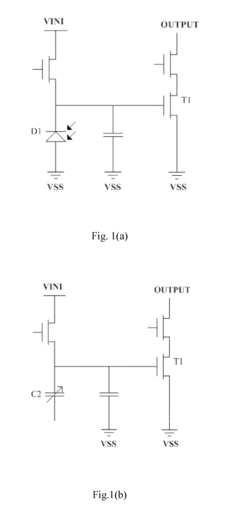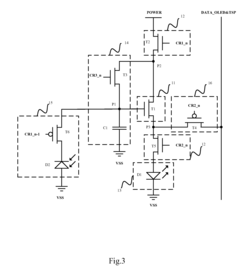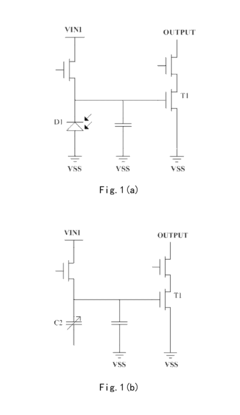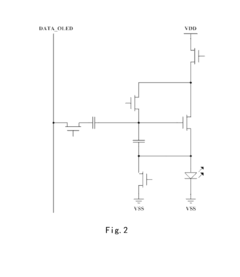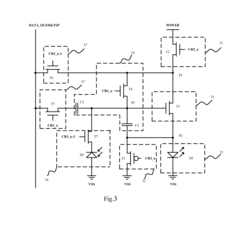Exploring microcontroller integration with AMOLED for interactive displays.
JUL 17, 20259 MIN READ
Generate Your Research Report Instantly with AI Agent
Patsnap Eureka helps you evaluate technical feasibility & market potential.
MCU-AMOLED Integration Background and Objectives
The integration of microcontrollers (MCUs) with Active-Matrix Organic Light-Emitting Diode (AMOLED) displays represents a significant technological advancement in the field of interactive display systems. This convergence aims to create more responsive, energy-efficient, and versatile display solutions for a wide range of applications, from consumer electronics to industrial interfaces.
The evolution of display technology has seen a shift from traditional LCD panels to AMOLED displays, which offer superior color reproduction, contrast ratios, and energy efficiency. Concurrently, microcontrollers have become increasingly powerful and compact, capable of handling complex tasks in real-time. The fusion of these two technologies seeks to leverage the strengths of both, creating a synergy that can revolutionize user interfaces and interactive experiences.
The primary objective of this integration is to develop display systems that are not only visually appealing but also highly interactive and intelligent. By directly coupling MCUs with AMOLED displays, developers aim to reduce latency, improve touch responsiveness, and enable more sophisticated display control algorithms. This integration also opens up possibilities for advanced features such as local dimming, adaptive refresh rates, and on-the-fly image processing, all of which can significantly enhance user experience and device performance.
Another key goal is to optimize power consumption. AMOLED displays are inherently more energy-efficient than LCDs, especially when displaying dark content. By integrating MCUs directly with these displays, power management can be fine-tuned at a pixel level, potentially extending battery life in portable devices or reducing energy costs in larger installations.
The trend towards this integration is driven by the increasing demand for more immersive and responsive user interfaces across various sectors. In the consumer electronics market, smartphones, smartwatches, and other wearable devices are prime candidates for MCU-AMOLED integration, as they require both high-quality displays and efficient processing in compact form factors. In automotive applications, this technology could enable more sophisticated in-vehicle infotainment systems and heads-up displays.
As we explore this integration, it's important to consider the technical challenges that need to be overcome. These include managing the high data rates required for driving high-resolution AMOLED displays, developing efficient communication protocols between the MCU and display driver, and ensuring compatibility with existing software ecosystems. Additionally, thermal management and electromagnetic interference (EMI) issues must be addressed to ensure reliable operation in various environmental conditions.
The successful integration of MCUs with AMOLED displays has the potential to set new standards in display technology, paving the way for more intelligent, responsive, and energy-efficient interactive systems across a wide spectrum of applications.
The evolution of display technology has seen a shift from traditional LCD panels to AMOLED displays, which offer superior color reproduction, contrast ratios, and energy efficiency. Concurrently, microcontrollers have become increasingly powerful and compact, capable of handling complex tasks in real-time. The fusion of these two technologies seeks to leverage the strengths of both, creating a synergy that can revolutionize user interfaces and interactive experiences.
The primary objective of this integration is to develop display systems that are not only visually appealing but also highly interactive and intelligent. By directly coupling MCUs with AMOLED displays, developers aim to reduce latency, improve touch responsiveness, and enable more sophisticated display control algorithms. This integration also opens up possibilities for advanced features such as local dimming, adaptive refresh rates, and on-the-fly image processing, all of which can significantly enhance user experience and device performance.
Another key goal is to optimize power consumption. AMOLED displays are inherently more energy-efficient than LCDs, especially when displaying dark content. By integrating MCUs directly with these displays, power management can be fine-tuned at a pixel level, potentially extending battery life in portable devices or reducing energy costs in larger installations.
The trend towards this integration is driven by the increasing demand for more immersive and responsive user interfaces across various sectors. In the consumer electronics market, smartphones, smartwatches, and other wearable devices are prime candidates for MCU-AMOLED integration, as they require both high-quality displays and efficient processing in compact form factors. In automotive applications, this technology could enable more sophisticated in-vehicle infotainment systems and heads-up displays.
As we explore this integration, it's important to consider the technical challenges that need to be overcome. These include managing the high data rates required for driving high-resolution AMOLED displays, developing efficient communication protocols between the MCU and display driver, and ensuring compatibility with existing software ecosystems. Additionally, thermal management and electromagnetic interference (EMI) issues must be addressed to ensure reliable operation in various environmental conditions.
The successful integration of MCUs with AMOLED displays has the potential to set new standards in display technology, paving the way for more intelligent, responsive, and energy-efficient interactive systems across a wide spectrum of applications.
Market Demand for Interactive AMOLED Displays
The market demand for interactive AMOLED displays integrated with microcontrollers has been experiencing significant growth in recent years. This surge is driven by the increasing consumer appetite for more sophisticated and responsive user interfaces across various devices, from smartphones and tablets to wearables and automotive displays.
In the consumer electronics sector, there is a growing trend towards devices that offer seamless touch interaction, gesture recognition, and adaptive display features. Smartphones, being the largest market segment, are continuously evolving to incorporate more interactive elements, with AMOLED displays providing superior color reproduction and energy efficiency. The integration of microcontrollers with these displays allows for more complex interactions and personalized user experiences, which are becoming key differentiators in the highly competitive mobile market.
The wearable technology market, including smartwatches and fitness trackers, is another area where the demand for interactive AMOLED displays is rapidly increasing. These devices require compact, energy-efficient displays that can provide clear visibility in various lighting conditions while offering touch functionality and quick response times. The combination of microcontrollers and AMOLED technology enables manufacturers to create more feature-rich and user-friendly wearable devices.
In the automotive industry, there is a rising demand for interactive infotainment systems and digital dashboards. AMOLED displays integrated with microcontrollers offer the potential for customizable interfaces, improved touch responsiveness, and enhanced visual quality, which are becoming increasingly important factors in modern vehicle design and user experience.
The gaming and virtual reality sectors are also driving the demand for interactive AMOLED displays. These applications require high refresh rates, low latency, and precise touch control, all of which can be achieved through the integration of advanced microcontrollers with AMOLED technology.
Furthermore, the industrial and medical sectors are showing increased interest in interactive AMOLED displays for use in control panels, diagnostic equipment, and monitoring devices. The ability to create intuitive, touch-enabled interfaces with high-quality visuals is particularly valuable in these fields where accuracy and ease of use are paramount.
As the Internet of Things (IoT) continues to expand, there is a growing need for smart displays in various connected devices. Interactive AMOLED displays with integrated microcontrollers are well-positioned to meet this demand, offering the flexibility and functionality required for diverse IoT applications.
In the consumer electronics sector, there is a growing trend towards devices that offer seamless touch interaction, gesture recognition, and adaptive display features. Smartphones, being the largest market segment, are continuously evolving to incorporate more interactive elements, with AMOLED displays providing superior color reproduction and energy efficiency. The integration of microcontrollers with these displays allows for more complex interactions and personalized user experiences, which are becoming key differentiators in the highly competitive mobile market.
The wearable technology market, including smartwatches and fitness trackers, is another area where the demand for interactive AMOLED displays is rapidly increasing. These devices require compact, energy-efficient displays that can provide clear visibility in various lighting conditions while offering touch functionality and quick response times. The combination of microcontrollers and AMOLED technology enables manufacturers to create more feature-rich and user-friendly wearable devices.
In the automotive industry, there is a rising demand for interactive infotainment systems and digital dashboards. AMOLED displays integrated with microcontrollers offer the potential for customizable interfaces, improved touch responsiveness, and enhanced visual quality, which are becoming increasingly important factors in modern vehicle design and user experience.
The gaming and virtual reality sectors are also driving the demand for interactive AMOLED displays. These applications require high refresh rates, low latency, and precise touch control, all of which can be achieved through the integration of advanced microcontrollers with AMOLED technology.
Furthermore, the industrial and medical sectors are showing increased interest in interactive AMOLED displays for use in control panels, diagnostic equipment, and monitoring devices. The ability to create intuitive, touch-enabled interfaces with high-quality visuals is particularly valuable in these fields where accuracy and ease of use are paramount.
As the Internet of Things (IoT) continues to expand, there is a growing need for smart displays in various connected devices. Interactive AMOLED displays with integrated microcontrollers are well-positioned to meet this demand, offering the flexibility and functionality required for diverse IoT applications.
Technical Challenges in MCU-AMOLED Integration
The integration of microcontrollers (MCUs) with Active-Matrix Organic Light-Emitting Diode (AMOLED) displays presents several significant technical challenges that need to be addressed for successful implementation in interactive display systems. These challenges stem from the inherent differences in the technologies and the complexities involved in their seamless integration.
One of the primary challenges is the high-speed data transfer required between the MCU and the AMOLED display. AMOLED displays typically operate at refresh rates of 60Hz or higher, demanding rapid data transmission to maintain smooth visual output. This necessitates a high-bandwidth interface between the MCU and the display driver, which can be difficult to achieve with traditional microcontroller architectures.
Power management poses another significant hurdle. AMOLED displays are known for their energy efficiency, but they still require careful power control to optimize performance and longevity. The MCU must be capable of precisely regulating power delivery to the display while managing its own power consumption, especially in battery-operated devices where energy efficiency is crucial.
The complexity of AMOLED display drivers presents a further challenge. These drivers often require sophisticated control signals and timing sequences that may exceed the capabilities of simpler MCUs. Implementing the necessary protocols and timing requirements can strain the processing power and memory resources of the microcontroller, potentially leading to performance bottlenecks.
Color management and calibration represent another area of technical difficulty. AMOLED displays are capable of producing vibrant colors, but maintaining color accuracy and consistency across the display requires complex algorithms and calibration procedures. The MCU must be capable of performing these calculations and adjustments in real-time, which can be computationally intensive.
Thermal management is also a critical concern in MCU-AMOLED integration. Both components generate heat during operation, and their close proximity in compact devices can lead to thermal issues. Effective heat dissipation and thermal design are essential to prevent performance degradation and ensure the longevity of both the MCU and the AMOLED display.
The need for touch integration adds another layer of complexity to the system. Many interactive displays incorporate touch functionality, requiring the MCU to process touch inputs while simultaneously driving the display. This multi-tasking capability demands careful resource allocation and efficient interrupt handling to maintain responsiveness.
Lastly, the physical integration of MCUs with AMOLED displays presents challenges in terms of form factor and connectivity. Designers must contend with limited space, especially in compact devices, while ensuring robust electrical connections between the components. This often requires custom PCB designs and careful consideration of signal integrity to minimize electromagnetic interference and maintain display quality.
One of the primary challenges is the high-speed data transfer required between the MCU and the AMOLED display. AMOLED displays typically operate at refresh rates of 60Hz or higher, demanding rapid data transmission to maintain smooth visual output. This necessitates a high-bandwidth interface between the MCU and the display driver, which can be difficult to achieve with traditional microcontroller architectures.
Power management poses another significant hurdle. AMOLED displays are known for their energy efficiency, but they still require careful power control to optimize performance and longevity. The MCU must be capable of precisely regulating power delivery to the display while managing its own power consumption, especially in battery-operated devices where energy efficiency is crucial.
The complexity of AMOLED display drivers presents a further challenge. These drivers often require sophisticated control signals and timing sequences that may exceed the capabilities of simpler MCUs. Implementing the necessary protocols and timing requirements can strain the processing power and memory resources of the microcontroller, potentially leading to performance bottlenecks.
Color management and calibration represent another area of technical difficulty. AMOLED displays are capable of producing vibrant colors, but maintaining color accuracy and consistency across the display requires complex algorithms and calibration procedures. The MCU must be capable of performing these calculations and adjustments in real-time, which can be computationally intensive.
Thermal management is also a critical concern in MCU-AMOLED integration. Both components generate heat during operation, and their close proximity in compact devices can lead to thermal issues. Effective heat dissipation and thermal design are essential to prevent performance degradation and ensure the longevity of both the MCU and the AMOLED display.
The need for touch integration adds another layer of complexity to the system. Many interactive displays incorporate touch functionality, requiring the MCU to process touch inputs while simultaneously driving the display. This multi-tasking capability demands careful resource allocation and efficient interrupt handling to maintain responsiveness.
Lastly, the physical integration of MCUs with AMOLED displays presents challenges in terms of form factor and connectivity. Designers must contend with limited space, especially in compact devices, while ensuring robust electrical connections between the components. This often requires custom PCB designs and careful consideration of signal integrity to minimize electromagnetic interference and maintain display quality.
Current MCU-AMOLED Integration Solutions
01 Microcontroller integration for AMOLED display control
Microcontrollers are integrated with AMOLED displays to manage various aspects of display control, including pixel addressing, brightness adjustment, and power management. This integration allows for efficient control of the display's functionality and enables interactive features through the microcontroller's processing capabilities.- Microcontroller integration for AMOLED display control: Microcontrollers are integrated with AMOLED displays to manage various aspects of display control, including pixel addressing, brightness adjustment, and power management. This integration allows for efficient control of the display's functionality and enables interactive features through the microcontroller's processing capabilities.
- Touch sensing and gesture recognition in AMOLED displays: Microcontrollers are used to process touch input and recognize gestures on AMOLED displays. This integration enables interactive features such as touch-based navigation, multi-touch gestures, and pressure-sensitive input, enhancing user experience and expanding the display's functionality beyond visual output.
- Power management and energy efficiency: Microcontrollers play a crucial role in managing power consumption and improving energy efficiency of AMOLED displays. They control pixel activation, implement dynamic power saving modes, and optimize display brightness based on ambient light conditions, extending battery life in mobile devices.
- Display driver integration and pixel control: Microcontrollers are integrated with display driver circuits to control individual pixels in AMOLED displays. This integration allows for precise control over color reproduction, contrast, and refresh rates, enabling high-quality image rendering and smooth animations on the display.
- Adaptive display features and user interaction: Microcontrollers enable adaptive display features in AMOLED screens, such as automatic brightness adjustment, color temperature adaptation, and personalized display modes. These features enhance user interaction by dynamically adjusting the display based on user preferences, ambient conditions, and usage patterns.
02 Touch sensing and gesture recognition in AMOLED displays
Microcontrollers are used to process touch input and recognize gestures on AMOLED displays. This integration enables interactive features such as touch-based navigation, multi-touch gestures, and pressure-sensitive input, enhancing the user experience and expanding the display's functionality beyond visual output.Expand Specific Solutions03 Power efficiency and display optimization
Microcontrollers are employed to optimize power consumption and display performance in AMOLED screens. This includes implementing adaptive brightness control, selective pixel activation, and power-saving modes to extend battery life while maintaining display quality.Expand Specific Solutions04 Integration of sensors for enhanced interactivity
Microcontrollers facilitate the integration of various sensors with AMOLED displays, such as ambient light sensors, proximity sensors, and accelerometers. This integration enables context-aware display adjustments and interactive features that respond to environmental conditions and device orientation.Expand Specific Solutions05 Display driver integration and pixel control
Microcontrollers are integrated with display driver circuits to provide precise control over individual pixels in AMOLED displays. This integration allows for advanced features such as local dimming, HDR rendering, and dynamic refresh rate adjustment, improving overall display quality and energy efficiency.Expand Specific Solutions
Key Players in MCU and AMOLED Industries
The integration of microcontrollers with AMOLED for interactive displays is in a growth phase, with increasing market demand and technological advancements. The market size is expanding as more consumer electronics and automotive industries adopt this technology. Companies like Samsung Electronics, BOE Technology Group, and Innolux Corp. are at the forefront, investing heavily in R&D to improve AMOLED technology and its integration with microcontrollers. The technology's maturity is progressing rapidly, with firms like Everdisplay Optronics and Tianma Microelectronics making significant strides in developing more efficient and responsive interactive displays. However, challenges remain in achieving cost-effective mass production and optimizing power consumption for widespread adoption.
BOE Technology Group Co., Ltd.
Technical Solution: BOE has developed an innovative approach to integrating microcontrollers with AMOLED displays for interactive applications. Their solution involves embedding low-power microcontrollers directly into the display backplane, allowing for localized processing and touch sensing[1]. This integration enables more responsive touch interfaces and reduces the main system's processing load. BOE's technology utilizes a specialized LTPS (Low-Temperature Polycrystalline Silicon) backplane that incorporates both the display circuitry and microcontroller elements[3]. This approach allows for distributed computing across the display surface, enabling features like local dimming, adaptive refresh rates, and advanced touch recognition without significant power consumption increases[5].
Strengths: Improved touch responsiveness, reduced main processor load, and potential for advanced display features. Weaknesses: Increased manufacturing complexity and potential yield issues due to the integration of multiple technologies.
Samsung Electronics Co., Ltd.
Technical Solution: Samsung has pioneered a unique approach to microcontroller integration with AMOLED displays, focusing on their proprietary ISOCELL technology. This solution incorporates microcontrollers within each pixel, allowing for individual pixel-level control and sensing[2]. The ISOCELL-enhanced AMOLED displays feature embedded memory and processing capabilities at the pixel level, enabling advanced functions such as local dimming, in-display fingerprint sensing, and adaptive power management[4]. Samsung's technology also includes a novel touch-integrated circuit that works in conjunction with the pixel-level microcontrollers to provide ultra-fast touch response and pressure sensitivity[6]. This integrated approach significantly reduces the need for external components and simplifies the overall display system architecture.
Strengths: Highly granular control over display elements, advanced touch and biometric capabilities, and simplified system design. Weaknesses: Potentially higher production costs and increased power consumption at the display level.
Core Innovations in MCU-AMOLED Interfacing
Active matrix organic light emitting diode pixel unit circuit, display panel and electronic product
PatentActiveUS9459721B2
Innovation
- The AMOLED pixel unit circuit is redesigned to include a light emitting module, a driving module, a threshold compensating module, a light emission controlling module, a touch sensing module, and an induction signal outputting module, which utilize existing data lines and control signals to integrate the TSP in Cell circuit, sharing circuit elements and control signals to minimize additional components.
Active matrix organic light emitting diode pixel unit circuit and display panel
PatentActiveUS9530354B2
Innovation
- An active matrix organic light emitting diode pixel unit circuit is designed with specific modules such as a light emitting module, driving module, threshold compensation module, light emitting control module, touch sensing module, and sensing signal output module, utilizing common data lines and control signals to integrate the TSP in Cell circuit, including additional TFTs and capacitors, while optimizing circuit components and signal operations.
Power Management Strategies for MCU-AMOLED Systems
Power management is a critical aspect of integrating microcontrollers with AMOLED displays for interactive applications. Efficient power utilization ensures longer battery life and improved overall system performance. One key strategy involves implementing dynamic voltage and frequency scaling (DVFS) for the microcontroller. By adjusting the operating voltage and clock frequency based on the current workload, power consumption can be significantly reduced during periods of low activity.
Another effective approach is the use of power gating techniques. This involves selectively shutting down unused portions of the microcontroller or AMOLED display when they are not required. For instance, certain peripherals or display regions can be powered off during standby modes, dramatically reducing static power consumption.
Intelligent display refresh strategies play a crucial role in power management. Implementing partial updates, where only changed portions of the display are refreshed, can substantially decrease power usage compared to full-frame updates. Additionally, adaptive refresh rates that adjust based on content type and user interaction can optimize power consumption without compromising user experience.
The integration of low-power modes is essential for MCU-AMOLED systems. These modes allow the system to enter various states of reduced functionality and power consumption when full performance is not needed. For example, implementing a deep sleep mode where only essential components remain active can extend battery life during idle periods.
Efficient power distribution and regulation are vital for minimizing energy losses. Implementing high-efficiency voltage regulators and power management ICs (PMICs) can help maintain stable power delivery while minimizing conversion losses. Moreover, careful PCB design with proper power plane separation and decoupling can further enhance power efficiency.
Leveraging the unique characteristics of AMOLED displays can contribute to power savings. Unlike traditional LCDs, AMOLEDs can selectively illuminate individual pixels, allowing for true black pixels that consume minimal power. Designing user interfaces and content that take advantage of this property can lead to significant power reductions, especially in applications with dark themes or partially active displays.
Lastly, implementing energy harvesting techniques can supplement battery power in certain applications. For wearable or IoT devices integrating MCU-AMOLED systems, technologies such as solar cells, thermoelectric generators, or kinetic energy harvesters can be employed to extend operational time between charges or potentially achieve self-sustained operation in low-power scenarios.
Another effective approach is the use of power gating techniques. This involves selectively shutting down unused portions of the microcontroller or AMOLED display when they are not required. For instance, certain peripherals or display regions can be powered off during standby modes, dramatically reducing static power consumption.
Intelligent display refresh strategies play a crucial role in power management. Implementing partial updates, where only changed portions of the display are refreshed, can substantially decrease power usage compared to full-frame updates. Additionally, adaptive refresh rates that adjust based on content type and user interaction can optimize power consumption without compromising user experience.
The integration of low-power modes is essential for MCU-AMOLED systems. These modes allow the system to enter various states of reduced functionality and power consumption when full performance is not needed. For example, implementing a deep sleep mode where only essential components remain active can extend battery life during idle periods.
Efficient power distribution and regulation are vital for minimizing energy losses. Implementing high-efficiency voltage regulators and power management ICs (PMICs) can help maintain stable power delivery while minimizing conversion losses. Moreover, careful PCB design with proper power plane separation and decoupling can further enhance power efficiency.
Leveraging the unique characteristics of AMOLED displays can contribute to power savings. Unlike traditional LCDs, AMOLEDs can selectively illuminate individual pixels, allowing for true black pixels that consume minimal power. Designing user interfaces and content that take advantage of this property can lead to significant power reductions, especially in applications with dark themes or partially active displays.
Lastly, implementing energy harvesting techniques can supplement battery power in certain applications. For wearable or IoT devices integrating MCU-AMOLED systems, technologies such as solar cells, thermoelectric generators, or kinetic energy harvesters can be employed to extend operational time between charges or potentially achieve self-sustained operation in low-power scenarios.
Standardization Efforts in MCU-AMOLED Integration
Standardization efforts in MCU-AMOLED integration have been gaining momentum as the industry recognizes the need for consistent protocols and interfaces to streamline development and improve interoperability. Several key organizations and industry consortia have been at the forefront of these initiatives, working to establish common standards that can benefit both manufacturers and end-users.
The MIPI Alliance has been particularly active in this space, developing specifications that address the unique requirements of mobile and mobile-influenced industries. Their Display Serial Interface (DSI) and Display Command Set (DCS) standards have been widely adopted for AMOLED displays, providing a foundation for MCU integration. These standards define the physical layer and command protocols, enabling efficient communication between MCUs and AMOLED panels.
In parallel, the Video Electronics Standards Association (VESA) has been working on standards that can be applied to a broader range of display technologies, including AMOLED. Their Embedded DisplayPort (eDP) standard, while primarily used in larger devices, has potential applications in MCU-AMOLED integration for more advanced interactive displays.
The JEDEC Solid State Technology Association has also contributed to standardization efforts, particularly in the realm of memory interfaces that are crucial for buffering and processing display data. Their Low Power Double Data Rate (LPDDR) specifications have been evolving to meet the demands of increasingly complex display systems, including those integrating MCUs with AMOLED displays.
Industry-specific consortia, such as the Automotive Display Industry Consortium (ADIC), have been focusing on standardization efforts tailored to particular sectors. For automotive applications, where AMOLED displays are becoming more prevalent, these efforts aim to ensure reliability, performance, and compatibility across different vehicle platforms and MCU architectures.
Open-source initiatives have also played a role in standardization. Projects like the Linux kernel's Direct Rendering Manager (DRM) subsystem have been extended to support various display technologies, including AMOLED, providing a standardized framework for MCU integration in embedded systems running Linux-based operating systems.
Despite these efforts, challenges remain in achieving full standardization across the MCU-AMOLED integration landscape. The rapid pace of technological advancement in both MCU and AMOLED technologies often outpaces standardization processes. Additionally, proprietary solutions developed by major players in the industry can sometimes hinder the adoption of universal standards.
Looking forward, there is a growing recognition of the need for more comprehensive standardization efforts that address not only the hardware interfaces but also software APIs and power management protocols specific to MCU-AMOLED integration. This holistic approach aims to create a more unified ecosystem that can accelerate innovation and reduce development costs for interactive display applications.
The MIPI Alliance has been particularly active in this space, developing specifications that address the unique requirements of mobile and mobile-influenced industries. Their Display Serial Interface (DSI) and Display Command Set (DCS) standards have been widely adopted for AMOLED displays, providing a foundation for MCU integration. These standards define the physical layer and command protocols, enabling efficient communication between MCUs and AMOLED panels.
In parallel, the Video Electronics Standards Association (VESA) has been working on standards that can be applied to a broader range of display technologies, including AMOLED. Their Embedded DisplayPort (eDP) standard, while primarily used in larger devices, has potential applications in MCU-AMOLED integration for more advanced interactive displays.
The JEDEC Solid State Technology Association has also contributed to standardization efforts, particularly in the realm of memory interfaces that are crucial for buffering and processing display data. Their Low Power Double Data Rate (LPDDR) specifications have been evolving to meet the demands of increasingly complex display systems, including those integrating MCUs with AMOLED displays.
Industry-specific consortia, such as the Automotive Display Industry Consortium (ADIC), have been focusing on standardization efforts tailored to particular sectors. For automotive applications, where AMOLED displays are becoming more prevalent, these efforts aim to ensure reliability, performance, and compatibility across different vehicle platforms and MCU architectures.
Open-source initiatives have also played a role in standardization. Projects like the Linux kernel's Direct Rendering Manager (DRM) subsystem have been extended to support various display technologies, including AMOLED, providing a standardized framework for MCU integration in embedded systems running Linux-based operating systems.
Despite these efforts, challenges remain in achieving full standardization across the MCU-AMOLED integration landscape. The rapid pace of technological advancement in both MCU and AMOLED technologies often outpaces standardization processes. Additionally, proprietary solutions developed by major players in the industry can sometimes hinder the adoption of universal standards.
Looking forward, there is a growing recognition of the need for more comprehensive standardization efforts that address not only the hardware interfaces but also software APIs and power management protocols specific to MCU-AMOLED integration. This holistic approach aims to create a more unified ecosystem that can accelerate innovation and reduce development costs for interactive display applications.
Unlock deeper insights with Patsnap Eureka Quick Research — get a full tech report to explore trends and direct your research. Try now!
Generate Your Research Report Instantly with AI Agent
Supercharge your innovation with Patsnap Eureka AI Agent Platform!

